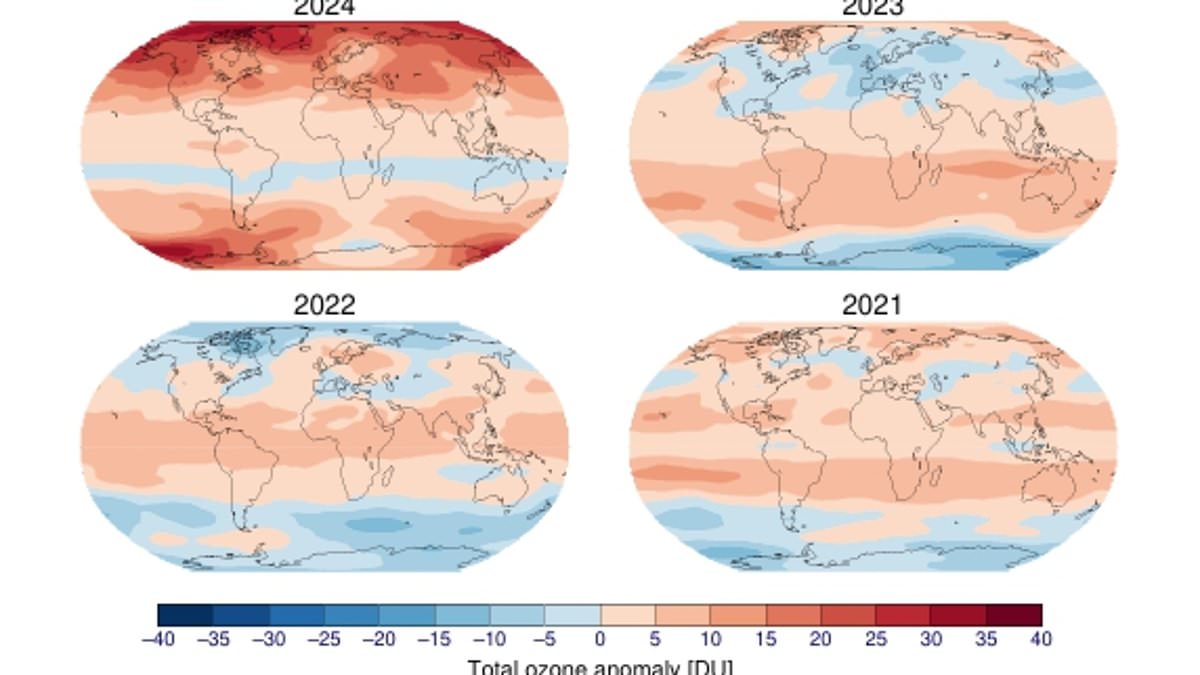The ozone layer is healing! Hole over Antarctica is recovering – and could soon close for good, promising study reveals
By Editor,Shivali Best
Copyright dailymail

The ozone layer is healing! Hole over Antarctica is recovering – and could soon close for good, promising study reveals
READ MORE: Ozone may be weakening Earth’s important cooling mechanism
By SHIVALI BEST, SCIENCE & TECHNOLOGY EDITOR
Published: 13:49 BST, 16 September 2025 | Updated: 13:49 BST, 16 September 2025
It has been four decades since scientists discovered the growing hole in Earth’s ozone layer.
But a promising new study has revealed that this protective shield – around 20 miles above our planet’s surface – could be well on its way to recovery.
Experts from the World Meteorological Organisation (WMO) say that, compared to previous years, total stratospheric ozone cover was higher over much of the globe in 2024.
What’s more, the ozone hole that appears over Antarctica every spring was well below the 1990–2020 average.
‘The ozone layer is healing,’ said Antonio Guterres, the United Nations Secretary–General.
‘This achievement reminds us that when nations heed the warnings of science, progress is possible.’
If progress continues at the current pace, the ozone layer could soon recover to its 1980 values (before the appearance of the ozone hole).
The experts predict that a full recovery could take place by around 2066 over the Antarctic, by 2045 over the Arctic, and by 2040 for the rest of the world.
Experts from the World Meteorological Organisation (WMO) say that, compared to previous years, total stratospheric ozone cover was higher over much of the globe in 2024
The ozone layer is Earth’s ‘natural sunscreen’ that protects humans, plants, and animals by filtering out harmful UV–B radiation.
Without it, we’d be at significantly increased risks of skin cancer, cataracts, and ecosystem damage due to excessive UV exposure.
Back in the 1970s, scientists first raised concerns about the effect of man–made chemicals known as chlorofluorocarbons (CFCs) on the ozone layer.
Concerningly, CFCs were used in a range of products, including refrigeration, air conditioning, firefighting foam, and even hairspray.
An international treaty called the Montreal Protocol was signed in 1987, leading to the phase–out of over 99 per cent of these ozone–depleting chemicals.
However, it was too late – a huge hole had already appeared in the ozone layer over Antarctica.
Beyond CFCs, the ozone hole has also been kept open by global warming.
‘A side effect of global warming is that the temperature of the ozone layer is falling slightly,’ explained the British Antarctic Survey.
The ozone hole that appears over Antarctica every spring was well below the 1990–2020 average
‘This means that more of the stratospheric clouds can form over Antarctica, and hence delay the recovery of the Antarctic ozone hole.’
Now, promising data shows that the depth of the ozone hole was below average in 2024, with a maximum ozone mass deficit of 46.1 million tonnes on 29 September.
Scientists reveal how many deaths could be prevented if greenhouse gas emissions are reduced
‘Its onset was relatively slow, and delayed ozone depletion was observed through the month of September, followed by a relatively rapid recovery after the maximum deficit was reached,’ WMO explained in its report.
‘The below-average level of ozone loss persisted through mid-November.’
While this is promising, the experts say our work is ‘not yet finished’.
‘There remains an essential need for the world to continue careful systematic monitoring of both stratospheric ozone and of ozone-depleting substances and their replacements,’ said Matt Tully, Chair of WMO’s Scientific Advisory Group on Ozone and Solar UV Radiation.
The Ozone layer sits in the stratosphere 25 miles above the Earth’s surface and acts like a natural sunscreen
Ozone is a molecule comprised of three oxygen atoms that occurs naturally in small amounts.
In the stratosphere, roughly seven to 25 miles above Earth’s surface, the ozone layer acts like sunscreen, shielding the planet from potentially harmful ultraviolet radiation that can cause skin cancer and cataracts, suppress immune systems and also damage plants.
It is produced in tropical latitudes and distributed around the globe.
Closer to the ground, ozone can also be created by photochemical reactions between the sun and pollution from vehicle emissions and other sources, forming harmful smog.
Although warmer-than-average stratospheric weather conditions have reduced ozone depletion during the past two years, the current ozone hole area is still large compared to the 1980s, when the depletion of the ozone layer above Antarctica was first detected.
In the stratosphere, roughly seven to 25 miles above Earth’s surface, the ozone layer acts like sunscreen, shielding the planet from potentially harmful ultraviolet radiation
This is because levels of ozone-depleting substances like chlorine and bromine remain high enough to produce significant ozone loss.
In the 1970s, it was recognised that chemicals called CFCs, used for example in refrigeration and aerosols, were destroying ozone in the stratosphere.
In 1987, the Montreal Protocol was agreed, which led to the phase-out of CFCs and, recently, the first signs of recovery of the Antarctic ozone layer.
The upper stratosphere at lower latitudes is also showing clear signs of recovery, proving the Montreal Protocol is working well.
But the new study, published in Atmospheric Chemistry and Physics, found it is likely not recovering at latitudes between 60°N and 60°S (London is at 51°N).
The cause is not certain but the researchers believe it is possible climate change is altering the pattern of atmospheric circulation – causing more ozone to be carried away from the tropics.
They say another possibility is that very short-lived substances (VSLSs), which contain chlorine and bromine, could be destroying ozone in the lower stratosphere.
VSLSs include chemicals used as solvents, paint strippers, and as degreasing agents.
One is even used in the production of an ozone-friendly replacement for CFCs.
United NationsEarth
Share or comment on this article:
The ozone layer is healing! Hole over Antarctica is recovering – and could soon close for good, promising study reveals
Add comment



